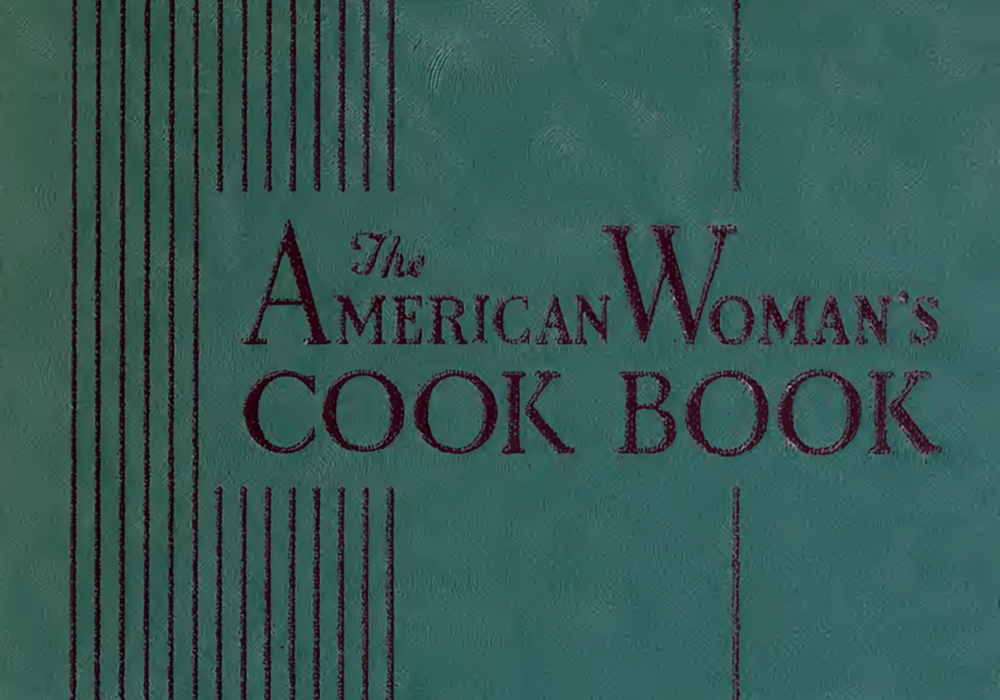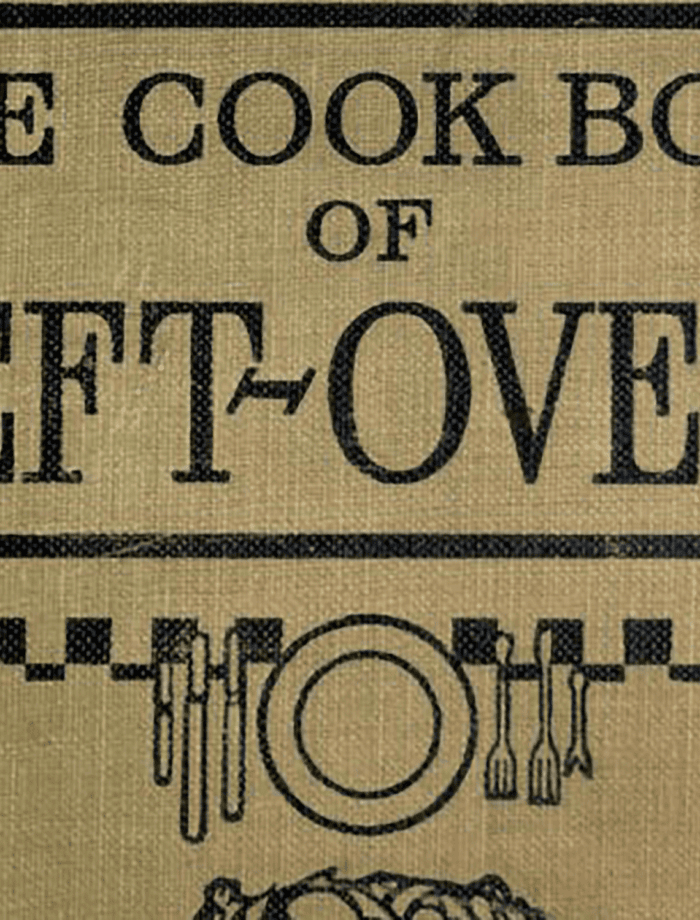Inspired by the best finds from the Internet Archive, we’re deep diving into the digitized cookbook collection–time traveling to bygone kitchens and learning more about the cooks + chefs behind the reads. Let’s dig in!

If you were a woman in the U.S. in the mid 20th century, you probably had a copy of The American Woman’s Cook Book in your kitchen. Published in 1939, the encyclopedic collection was edited by Ruth Berolzheimer, director of the Culinary Arts Institute in Chicago. It was one of the first cookbooks to use four-color photography, and sold 8 million copies by the early 1970s. The tome clocks in at over 800 pages, offering guidance for meal planning, grocery shopping, menu making, table setting, and entertaining; and contains hundreds of recipes to suit any occasion. Highlights of its table of contents include ‘Soup Accessories,’ ‘The School Lunch,’ ‘Sauces for Desserts,’ ‘High Altitude Cooking,’ and ‘Toast.’
According to a 2008 interview in the Chicago Reader with Ruth Berolzheimer’s nephew, the success of The American Woman’s Cook Book was but single a line on her impressive and polymathic resume. At 17, Ruth founded the first Hebrew school in her home town of Chicago Heights. She attended the University of Illinois in Champaign, and became the second woman in the school’s history to graduate with a degree in chemical engineering. After college, Ruth defected from the woman in STEM life to pursue social work, and landed the position of assistant director at Milwaukee’s Abraham Lincoln House, a community center for Jewish immigrant women. Ruth later relocated to New York City, where she pivoted yet again to food writing, serving as managing editor for a magazine called Good Eating. She eventually made her way back to Chicago and commenced the final leg of her career as director of one of the largest cookbook publishers in the country.
Considering such Girl Boss behavior I’m honestly shocked Ms. Berolzheimer doesn’t have her own Wikipedia page, let alone the biographical mini series I’d personally be hungry to watch. But what can a single Jewish woman gourmand expect in this patriarchal media hellscape I suppose.

As an American Woman seeking to honor Ruth’s legacy, I whipped up a recipe from The American Woman’s Cook Book with a 2023 twist. I chose a dish named, iconically, ‘Carrots, Toasted.’ It appears in the ‘Vegetables’ section betwixt ‘Scalloped Cabbage’ and ‘Boiled Cauliflower.’ The recipe reads as follows:
Carrots, Toasted
To serve carrots as a separate vegetable, scrape and wash; leave young carrots whole and cut old carrots in slices length-wise or crosswise. Boil them until tender (15-30 minutes) in water containing one teaspoon sugar. Just before cooking is completed, salt the water. Drain, add butter and seasoning, or roll in butter, then in corn flakes and brown in oven at 350° F.
Notes:
- I scraped and washed my carrots, though not in that order. Are others peeling before they rinse? Much to consider.
- I appreciate the old carrots representation. Do not lament, just slice and boil.
- I nixed the sugar and added my salt right away. This was mostly because I was worried I’d forget if I waited.
- I subbed EVOO for the butter and seasoned with more salt, black pepper, and a pinch of ancho chili powder.
- I planned to try a corn flake breading but found my pantry conspicuously lacking cereal, so instead I crumbled a toasted a slice of sourdough.
- Ruth does not specify how long to bake your Carrots, Toasted, so I opted for about 35 minutes.
- Ultimately, it was delightful! You can’t go wrong roasting a root veg with a seasoned carb.

Most of the recipes in The American Woman’s Cook Book are similarly succinct and unadorned. Ruth curated a sensible collection for household cooking any time of year. In a time of intense frugality and uncertainty around world affairs, she also looked to to be expressive and inviting in her food. So let’s excuse the so called ‘Frozen Salads’ as an ill conception of the time. (In case you’re curious, they are explained thusly: Combined with whipped cream and mayonnaise, the mixture is frozen like mousse, but it should not be frozen long enough to harden the fruit or vegetable.)
Many recipes are scrappy in a manner that will be familiar to low-waste kitchenistas of today. Day-old rolls make excellent crostini appetizers! Beet greens are to be boiled until just tender and served hot with vinegar! Potatoes generally need not be peeled! These techniques have their origins in the resilient kitchens of a pre-WWII and post Depression era and remain helpful methods in contemporary cooking.A few recipes highlight the unappetizing thriftiness of the time. For example, ‘Mock Almonds,’ which are apparently merely croutons shaped to represent almonds. And ‘Water Toast,’ which is prepared like so: Toast bread until crisp and brown. Pour into a soup-plate one cup boiling water and one teaspoon salt. Dip the toast into this water and removed at once. Spread lightly with butter and serve immediately.

The book closes with what I see as the pièce de résistance — a number of useful indices including ‘Cooking for Two,’ and ‘Foreign Words and Phrases’; and extensive material on wine that bears such lovingly poetic language as, This passage of time affects wine as it does humans, for wine is a living thing. It becomes sick; it recovers; it is affected by the seasons, by heat and cold; it grows old; it dies — all this even after it has been bottled.
Perhaps my favorite chapter, titled ‘The Friends Who Honor Us,’ appears at the start of this section, and reads as a manifesto of sorts on best practices for social dining.
Informal gathering, as Ruth recommends, shall take place in the ‘rumpus room,’ which I gather is a feistier way of saying basement. The room is, of course, the ideal spot for taffy pulls and popcorn-ball parties of the oldsters’ childhood. If your rumpus room happens to boast provisions for cooking like an electric grill or fireplace, Ruth proposes us[ing] it for the camp cookery children enjoy on hikes — potatoes, sweet potatoes, whole eggs, or onions done in the hot ashes.
For more sophisticated cocktail parties, Ruth cautions against entrusting too much confidence in attendees to comport themselves gracefully. It is well to remember that all varnished furniture needs protection from the occasional careless guest. The foot of every stemmed glass should be provided with a jacket, and tall glasses equally well protected. Have plenty of coasters in addition. Now, I am not clear on what exactly these jackets look like but I can only imagine that Ruth was outfitting her glassware with timeless elegance.
If any of you reading this are tempted to host your own Berolzheimer-worthy fete, Ruth wisely urges you not to bite off more than you can chew. Many women can manage almost any form of entertainment without the help of a maid. For most, however, there are distinct limits to what should be attempted for pleasant and dignified results. And while some of her guidance is outlandish, we can absolutely do less and eat some water toast about it.

You can read the entirety of The American Woman’s Cook Book here!



